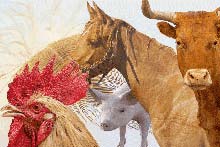What is lactose intolerance?
Lactose intolerance is a series of digestive system symptoms, such as abdominal distension, diarrhea and flatulence, caused by lactose being indigestible after eating foods or beverages containing lactose.If you have lactose malabsorption, your small intestine makes low levels of lactase—the enzyme that breaks down lactose—and can’t digest all the lactose you eat or drink.The undigested lactose passes into your colon. Bacteria in your colon break down the lactose and create fluid and gas. In some people, this extra fluid and gas causes lactose intolerance symptoms.In some cases, your genes are the main reason. Genes play a role in the following conditions, and these conditions can lead to low levels of lactase in your small intestine and lactose malabsorptionMain lactose sourcesLactose is a sugar found primarily in milk and other dairy products. So most dairy products contain lactose, but some contain more than others. The following foods contain the highest levels of lactose.1. Milk: Milk contains the most lactose out of all the dairy products. Whole milk contains about 13 grams of lactose per 1-cup serving, while skim milk can contain between 12 and 13 grams. Milk is also an ingredient in many other foods like margarine, shortening, baked goods, salad dressing, creamers, and more.2. Cheese:Cheese also contains a high amount of lactose. Hard cheeses such as parmesan, Swiss, and cheddar may be easier to digest because most of the lactose is eliminated while the cheese is being made.3. Ice cream etc.:Products made from cream — like ice cream, cream cheese, custard, or butter — should be avoided due to the high levels of lactose.What is the difference between lactose intolerance and milk allergy?
Lactose intolerance and milk allergy are caused by substances with different components. The former is caused by lactose (the natural sugar in milk) digestion problems. Conversely, the latter is caused by the immune system’s response to one or more proteins in milk and milk products.Milk allergy most often occurs in the first year of life, while lactose intolerance usually occurs later. Lactose intolerance can lead to discomfort, while severe allergic reactions to milk can be life-threatening.Who’s affected
Around 75% of the world’s population has some form of lactose intolerance. Some can digest low-lactose diets, while others experience digestive symptoms after eating any amount of dairy. That is to say, not everyone with lactose malabsorption will have digestive symptoms after eating lactose.An estimated 30 million to 50 million Americans have lactose intolerance, according to the University of Maryland Medical Center.In the UK, lactose intolerance is more common in people of Asian or African-Caribbean descent.Lactose intolerance can develop at any age. Many cases first develop in people aged 20 to 40, although babies and young children can also be affected.Lactose-Controlled Diet
There’s no cure for lactose intolerance, but cutting down on food and drink containing lactose usually helps to control the symptoms.1. Lactose-free milk or soy milk3. In addition to some kinds of cheeses, some people with lactose intolerance may be able to eat yogurt in moderation, as the lactose has been partly broken down.
4. While milk chocolate contains less lactose than milk or cream, it still contains dairy in high amounts. Always check the label and eat in moderation.








